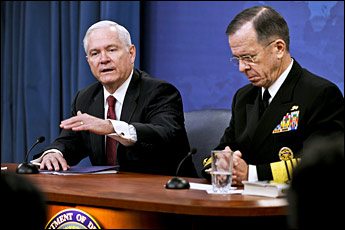Secretary of Defense Robert M. Gates announced today a series of efficiencies decisions designed to save the Department of Defense more than $150 billion over the next five years primarily by reducing overhead costs, improving business practices and culling excess or troubled programs. Most of the resulting savings will be used by the Army, Navy, Marine Corps and Air Force to invest in high priority programs that strengthen warfighting capabilities.
In anticipation of an era of modest defense budget growth, Gates launched a comprehensive effort last May to reduce the Department’s overhead expenditures. The goal was to sustain the military’s size and strength over the long term by reinvesting those efficiency savings in force structure and other key combat capabilities.
Specifically, the military services were directed to find at least $100 billion in savings that they could keep and shift to higher priority programs. To achieve the savings targets, service leadership conducted a thorough and vigorous scrub of bureaucratic structures, facilities, programs, business practices, civilian and military personnel levels, and associated overhead costs.
The measures announced today are the latest in a series of DoD reform initiatives, to include the President’s last two annual defense budgets, which have rebalanced the Department’s spending habits while increasing investments in proven capabilities most relevant both to current wars and to the most likely future threats.
“Meeting real-world requirements. Doing right by our people. Reducing excess. Being more efficient. Squeezing costs. Setting priorities and sticking to them. Making tough choices. These are all things that we should do as a Department and as a military regardless of the time and circumstance. But they are more important than ever at a time of extreme fiscal duress, when budget pressures and scrutiny fall on all areas of government, including defense,” said Gates.
“While America is at war and confronts a range of future security threats, it is important to not repeat the mistakes of the past by making drastic and ill-conceived cuts to the overall defense budget. At the same time, it is imperative for this Department to eliminate wasteful, excessive, and unneeded spending. Indeed, to do everything we can to make every defense dollar count.”
The service departments achieved savings in several areas, including the number and size of headquarters staffs, base operations, energy consumption, and facilities sustainment. At the same time, the service leaders undertook the normal process of setting priorities and assessing risks in preparing the fiscal 2012 budget request – a process that led to the recommended termination or restructuring of a number of troubled or unneeded weapons programs.
The services will keep the savings they were motivated to find and reinvest in the needed capabilities each service needs to support the warfighter. The bulk of the savings will be used by the service departments to make key investments in areas such as ship building, long-range strike, missile defense, intelligence, reconnaissance and surveillance (ISR), wounded warrior care and facilities, and much more.
Specifically, the Department of the Navy is proposing to use efficiencies savings to:
- Accelerate development of a new generation of electronic jammers to improve the Navy’s ability to fight and survive in an anti-access environment;
- Increase the repair and refurbishment of Marine equipment used in Iraq and Afghanistan;
- Develop a new generation of sea-borne unmanned strike and surveillance aircraft;
- Buy more of the latest model F-18s and extend the service life of 150 of these aircraft as a hedge against more delays in the deployment of the Joint Strike Fighter (JSF); and
- Purchase additional ships – including a destroyer, a littoral combat ship, an ocean surveillance vessel and fleet oilers.
The Department of the Navy proposed efficiencies savings of more than $35 billion over five years to include:
- Reducing manpower ashore and reassigning 6,000 personnel to operational missions at sea;
- Using multi-year procurement to save more than $1.3 billion on the purchase of new airborne surveillance, jamming, and fighter aircraft;
- Disestablishing several staffs (but not the associated platforms) to include submarine-, patrol aircraft-, and destroyer-squadrons plus one carrier strike group staff; and
- Disestablishing the headquarters of Second Fleet at Norfolk, Va., and transferring responsibility for its mission to the Navy’s Fleet Forces Command.
For the Department of the Air Force, this efficiencies process made it possible to:
- Buy more of the most advanced Reaper UAVs and move essential ISR programs from the temporary war budget to the permanent base budget. Going forward, advanced unmanned strike and reconnaissance capabilities must become an integrated part of the service’s regular institutional force structure;
- Increase procurement of the Evolved Expendable Launch Vehicle to assure access to space for both military and other government agencies while sustaining our industrial base;
- Modernize the radars of F-15s to keep this key fighter viable well into the future;
- Buy more simulators for JSF air crew training; and
- Develop a new long range, nuclear-capable penetrating bomber, which will be designed using proven technologies, an approach that should make it possible to deliver this capability on schedule and in quantity.
The Air Force proposed efficiencies measures that will total some $34 billion over five years and include:
- Consolidating two air operations centers in the United States and two in Europe;
- Consolidating three numbered Air Force staffs;
- Saving $500 million by reducing fuel and energy consumption within the Air Mobility Command;
- Improving depot and supply chain business processes to sustain weapons systems, thus improving readiness at lower cost; and
- Reducing the cost of communications infrastructure by 25 percent.
The Department of the Army would use its savings to:
- Provide improved suicide prevention and substance abuse counseling for soldiers;
- Modernize its battle fleet of Abrams tanks, Bradley fighting vehicles, and Stryker wheeled vehicles;
- Accelerate fielding to the soldier level of the Army’s new tactical communications network.
- Accelerate procurement of the service’s most advanced Grey Eagle UAVs; and
- Buy more MC-12 reconnaissance aircraft to support ground forces, and begin development of a new vertical unmanned air system to support the Army in the future.
The Army proposed $29 billion in savings over five years to include:
- Terminating the SLAMRAAM surface to air missile, and the Non-Line of Sight Launch System, the next-generation missile launcher originally conceived as part of the Future Combat System;
- Reducing manning by more than 1,000 positions by eliminating unneeded task forces and consolidating six installation management commands into four;
- Saving $1.4 billion in military construction costs by sustaining existing facilities; and
- Consolidating the service’s email infrastructure and data centers, which should save $500 million over five years.
Of the $100 billion identified by the service departments, approximately $28 billion will also be used over the next five years by the Army, Air Force, Navy and Marine Corps to deal with higher than expected operating expenses such as fuel, maintenance, health care and training costs.
In addition to directing the four services to find savings, Gates announced last August a set of initiatives aimed at reducing overhead costs and improving efficiency across the DoD as a whole – with special attention to the headquarters and support bureaucracies in the Office of the Secretary of Defense, the combatant commands, and other defense agencies and field activities.
Gates announced today that this effort – combined with a government-wide freeze on civilian salaries – has yielded approximately $54 billion in savings over the next five years. These savings include further reducing the contractor staff cadre, consolidating IT support, culling redundant intelligence organizations, eliminating unnecessary reports and studies, freezing civilian staff levels and pay, downgrading overseas commands, decreasing the number of generals, admirals and civilian executives, and modest increases in TRICARE premiums on military retirees.
In addition to terminating the Marine Corps’ Expeditionary Fighting Vehicle, Gates also stated that he is placing the Marine Corps’ short take-off and vertical landing (STOVL) variant of the JSF on the equivalent of a two-year probation because of significant testing problems. As a result, the development of the Marine variant will be moved to the back of the overall JSF production sequence. To fill the gap created from the slip in the JSF production schedule, the Department of the Navy will buy more Navy F/A-18s.
The formal announcement of the President’s fiscal 2012 budget submission next month is also expected to call for a $78 billion reduction to the FYDP, to include no real growth in defense spending in fiscal 2015 and fiscal 2016. But because of the rigorous reform efforts undertaken over the past year, it is possible for the DoD to absorb this reduction in the projected top-line without significant impact to warfighting capability, although it will necessitate a reduction in the size of the Army and Marine Corps starting in fiscal 2015. The total savings generated by DoD-wide overhead efficiencies, the civilian staffing and pay freeze, and the future decrease in ground forces, when added together, are roughly equivalent to the sum of the top-line reductions projected in the FYDP.
With the efficiencies savings, Gates said he is confident the Department can effectively meet the threats it is likely to face over the next few years. But he also stressed the FYDP represents the minimum level of defense spending necessary given the complex and unpredictable array of security challenges the United States faces around the globe. Beyond this five year time frame, the savings from overhead efficiencies and force reductions will have mostly run their course.
Gates concluded by talking about the importance of following through on all DoD reform measures while maintaining adequate levels of funding.
“This Department simply cannot risk continuing down the same path – where our investment priorities, bureaucratic habits, and lax attitudes towards costs are increasingly divorced from the real threats of today, the growing perils of tomorrow, and the nation’s grim financial outlook,” Gates declared at the conclusion of today’s announcement. “These times demand that all of our nation’s leaders rise above the politics and parochialism that have too often plagued considerations of our nation’s defense – whether from inside the Pentagon, from industry and interest groups, and from one end of Pennsylvania Avenue to the other. I look forward to working through the next phase of the President’s defense reform effort with the Congress in the weeks and months ahead – to do what’s right for our Armed Forces and what’s right for our country.”











